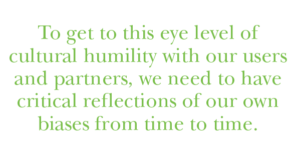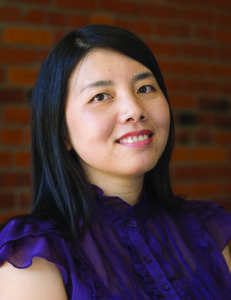By Huatong Sun
Inclusive design doesn’t just mean to represent and include different voices. A design process aiming for real inclusivity asks us to look at our users and communicate with them at the same eye level out of our humility, i.e., to empower from within. Being consciously aware of our systemic and personal biases is an important step leading towards this goal. Through this process, we help users utter their own voices and plant seeds to nurture culturally sustainable changes mutually in our communities.
Melinda Gates shared this story at the Goalkeepers Conference in 2019. One of their nonprofit organizations donated cows and provided training to help poor women farmers in Mozambique. Despite their goodwill, the program didn’t go anywhere. What part went wrong? It started from the program logistics: The program asked each family to send one person to pick up cows and receive training on caring for livestock. However, in a male-dominated rural culture, the person who came to pick up cows was always a man, though the women at home were caring for the cows. As a result, the folks who were doing the real work of tending livestock never received the training they needed, even though the original goal of the funding program was to eliminate gender inequality and support women’s entrepreneurship in rural regions.
This story demonstrates that details go a long way for inclusive design. To get to this eye level of cultural humility with our users and partners, we need to have critical reflections of our own biases from time to time.
This is a lesson I learned from my community engagement work in my design classes. For more than a decade, my advanced design classes have partnered with local underserved and under-resourced user groups who need a web presence or website upgrade for design empowerment. Our community partners include a Native American tribe, a free rural clinic, a multicultural center, a women’s center, and non-profit organizations for people with disabilities and LGBTQIA+ communities.
“This is Not Our History”
I will never forget this client comment at our design model demo session a dozen years ago when I began to include community design projects in my classes in a Midwestern university. My graduate class was designing a website prototype for an online exhibition of a Native American tribe targeted to the tribe community and beyond. Funded by a grant through the Institute of Museum and Library Services, this project aimed to bring the exhibition experience online for those tribe members who were unable to visit it in person due to distance.
Because most of the tribe members didn’t live in the local area, students collected information from our primary contact, “Ian,” the communication specialist of that tribe office, assigned by the office director, “Dakota,” a 40-year-old tribe member. Ian is a recent white male college graduate. He visited our class at the beginning of the project and answered a lot of questions about the client and the tribe we asked. We had a design model demo a few weeks later when Dakota came. After student groups presented their design concepts and wireframes, Dakota looked at us, “this is not our history.” The class was dumbfounded.

Dakota used the timeline as an example to explain. In the design model, students chronicled artifacts into three eras including one era of “the treaty period.” Dakota said that they would call that period “failed relationships.” The class realized that the naming of the timeline represented a colonist view of Native American history, which continually oppressed and hurt the feelings of the targeted audiences even though our original goal was to help them to celebrate their heritage.
What part went wrong? As a new college graduate, Ian probably didn’t realize his lack of tribe knowledge or awareness of his biases when he came to our class to give project information. He chronicled the tribe history with a mainstream view of the history he’s familiar with. As a teacher who just stepped into the deep water of community-engaged design, I took the information from the site primary contact for granted and didn’t critically assess it; I lost an opportunity of reminding my students to consider systemic bias and the residue of the power hierarchy during user research.
It was an eye-opening experience for everyone in that room. Shocked and also motivated, a student created a sidebar called “Voices” in her later design iteration. That sidebar brought together the tribe’s voices of the past, the present, and even the future! Voices of the past and the present were displayed in the forms of historical quotes that further explained the archived pieces and commentaries from those people who were able to visit the on-site exhibition. It also specifically reserved the space to invite future conversations, including comment fields for feedback and reflections from website visitors. It created a place for potential poems and short stories inspired by the pieces as transformative work. This concept was adopted as the main feature by other teams as well, and it was greatly appreciated by the client and user representative from the tribe in the final demo.
“We’re Networking. Not Volunteering.”
My undergraduate students were very disappointed after attending the board meeting of a local community coalition. That rural community is located in the backyard of two global tech giants in the Greater Seattle region, Amazon and Microsoft. It was hit heavily by the rapid gentrification waves, and experienced challenges such as food hunger and housing affordability as the region rose to what the Seattle Times called, “one of the most economically potent spots in North America.”
The coalition was founded fifteen years ago, beginning as a place for moms to exchange information and resources for raising kids, and later it expanded to become a clearinghouse for sharing and networking as a close community at the foot of a big mountain. One day the mayor ran into the coalition chair at a local meeting and said, “Your group has been doing great work for the community, but I cannot find your presence online. Why not have a website?” A nursing colleague who had been doing community work there for a few years connected my class with them.
My students were eager to help, and a group of them attended the next available monthly board meeting to research user requirements. Fifteen community members gathered in a meeting room of a local school district, who were affiliated with different local churches, community centers, school districts, facilities of health care, and community outreach offices of local organizations. At the meeting, my students and I were shocked to learn that some families had to pay $1,800 a month to live in a motel room in 2019; for comparison, the rent of an upscale three-bedroom townhouse in Bellevue was $2,200 eight years ago, 30 minutes north of this community. As people discussed plans to help motel families, the founder of the coalition reminded us: “We’re here networking, but not volunteering.” The next day a male student Erick reported this “confrontational moment” to the class and added that he felt like he was going to a gossiping club for housewives instead of a coalition. He said, “people in my community are living in motels. Why should we just do networking and share information, but not volunteer to make the changes right away?” His sentiment was echoed by the class.
It was a perfect storm and a messy design challenge, but it was also a good teaching and practice moment for inclusive design. With the help of the nursing colleague, I brought public health research about coalition practices and community assets to the class, and we had a lively discussion about what community empowerment means for this design project. I shared the quote of a public health researcher, Labonté, with my students: “Empower means ‘the ability to choose,’ or ‘to increase one’s capacity to define, analyze, and act upon one’s problems.’ We cannot ‘empower’ anyone; to presume so strips people of their capacity for choice. Empower is a reflexive verb; groups and individuals can only empower themselves. Our role may be to nurture this process and remove obstacles.”
Lessons in Empathy and Empowerment
For true design empowerment, we need to respect the self-determination of the community organization that corresponds to its core functions. As designers, many times we are there helping local communities we partner with for projects “temporarily,” and we leave after the project is over. To achieve more culturally sustainable design results, what we can do is to plant seeds, but not to enforce radical changes. Indeed, more impactful changes usually don’t happen immediately. Inclusive empowerment asks us to support our community partners and communicate with them at their eye level, i.e., following their own paces without imposing our preferences on them. It’s the same as what we do when our best friend approaches us for help: We try to be supportive, but not to be judgmental.
We brought our design prototypes to the board meeting in the following month. Students had a happy surprise—the mayor was there! Erick wrote in his end-of-quarter design reflection: “after this ‘confrontation’ it made me reflect and remember that my job was not to recreate the coalition, my job was to empathize and advocate for them. The way we would achieve this is through an efficient timeline and website, that promotes an effective system that engages with its audience to empower the coalition and promote the mission of the coalition.”
The lesson I learned as a teacher is that I thought WE, as designers, were to help and transform local communities through these types of community engagement projects. But in the end, both my students and I gained a new perspective for inclusivity, and we were transformed into better designers and better selves. As we planted seeds in local communities, we were also planting seeds in our own hearts. Empowering from within happens mutually.

HUATONG SUN (huatongs@gmail.com) is Associate Professor of Digital Media and Global User Experience Design at University of Washington Tacoma. She studies how to design and innovate for usable, meaningful, and empowering technology to bridge differences in a globalized world. The author of Cross-Cultural Technology Design (2012) and Global Social Media Design (2020) from Oxford University Press, she writes for pubic media like Fast Company and The Conversation, speaks at SXSW, STC, UXPA, CHI, and ATTW, and offers workshops at local SIGs and international conferences. Her Twitter handle is @huatongs.


